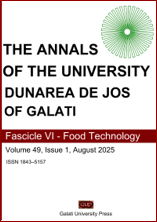Comparative analysis of bioactive compounds and amino acid profiles in wheat and wheatgrass (Triticum aestivum)
Abstract
This research offers an in-depth comparative examination of the amino acid profiles and bioactive substances in two different varieties of mature wheat grains (Triticum aestivum) and the young shoots of wheatgrass BARI gom 33. The amino acid profiles were analyzed using high-performance liquid chromatography (HPLC) after performing acid hydrolysis. Standardized methods were utilized to assess the bioactive compounds present. The results revealed significant variations in the amounts of both essential and non-essential amino acids, as well as bioactive compounds, between wheat and wheatgrass. Notably, wheatgrass exhibited higher concentrations of essential and non-essential amino acids, including histidine, lysine, phenylalanine, isoleucine, methionine, valine, threonine, serine, alanine, and tyrosine. This indicates that wheatgrass may have potential as a nutrient-dense dietary supplement. Wheatgrass exhibited significantly elevated levels of total phenols at 235 mg GAE/100g, total flavonoids at 166.3 mg QE/100g, and DPPH inhibition activity (70 %) compared with the mature wheat grain. Nonetheless, this research offers important information regarding the nutritional makeup of wheatgrass and mature wheat, emphasizing their unique amino acid and bioactive compound profiles. These results carry considerable implications for the possible health advantages related to wheatgrass consumption.


